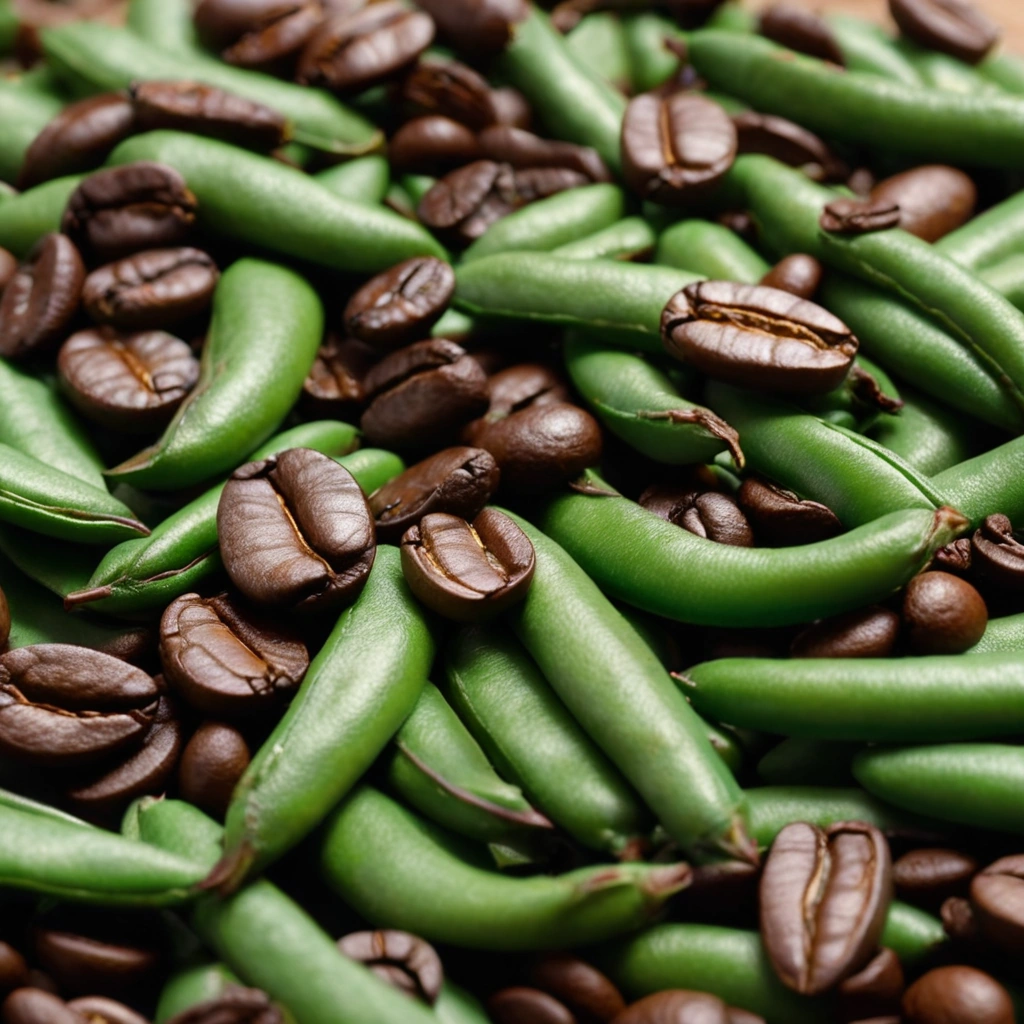The Allure of Home Coffee Roasting: Freshness, Control, and Flavor
The aroma of freshly roasted coffee is intoxicating, a siren song for coffee lovers. For years, that experience was largely confined to commercial roasters and specialty cafes. But now, home coffee roasting is experiencing a surge in popularity, empowering enthusiasts to take control of their coffee experience from green bean to brewed cup. Forget the stale, mass-produced beans on supermarket shelves. Home roasting offers unparalleled freshness, significant cost savings, and the ability to customize your roast profile to perfectly match your palate.
This comprehensive coffee roasting guide will demystify the process, providing you with the knowledge and tools to embark on your own coffee roasting journey, transforming you from a mere consumer into a curator of coffee experiences. Many believe home roasting is overly complex or requires expensive equipment. That’s a misconception. While professional-grade equipment exists, excellent results can be achieved with relatively simple and affordable setups. The key is understanding the fundamentals and practicing patience. As Marcell Coffee in Kansas City demonstrates, forging deeper connections with coffee begins with understanding its origins and nuances, something home roasting allows on a personal level.
One of the most compelling reasons to embrace home coffee roasting is the unparalleled freshness it provides. Commercially roasted coffee often sits on shelves for weeks, or even months, losing its volatile aromatic compounds and developing stale flavors. Roasting coffee beans at home allows you to enjoy coffee within days, or even hours, of roasting, maximizing the vibrancy and complexity of the bean. Furthermore, sourcing green coffee beans offers a broader selection than pre-roasted options.
You can explore single-origin beans from Ethiopia, known for their bright acidity and floral notes, or Sumatran beans, prized for their earthy and full-bodied character. This opens up a world of flavor possibilities unavailable to those limited to commercially roasted offerings. The ability to control the roast level empowers you to unlock the full potential of each bean, tailoring the flavor profile to your precise preferences. Beyond freshness and flavor control, home coffee roasting can also lead to significant cost savings over time.
While the initial investment in a home coffee roaster, whether it’s an air roaster like the FreshRoast SR540 or a small drum roaster, might seem daunting, the cost per cup decreases substantially when you purchase green coffee beans in bulk. Green coffee beans are typically much cheaper than their roasted counterparts, and the savings accumulate quickly, especially for those who consume coffee regularly. This allows enthusiasts to experiment with different origins and roast profiles without breaking the bank.
Moreover, the act of roasting coffee beans at home fosters a deeper appreciation for the entire coffee brewing process. Ultimately, home coffee roasting is about more than just producing a great cup of coffee; it’s about connecting with the source, understanding the nuances of flavor development, and creating a personalized coffee experience. Whether you choose to start with a simple stovetop coffee roasting setup or invest in a more sophisticated drum roaster, the journey of learning to roast coffee beans at home is a rewarding one. By mastering the fundamentals of heat control, airflow, and roast profiling, you can unlock a world of flavor and transform your daily coffee ritual into a truly exceptional experience. With readily available coffee roasting tips and a plethora of online resources, embarking on your home roasting adventure has never been easier.
Choosing Your Roasting Method: Air, Drum, and Stovetop
Several methods exist for roasting coffee at home, each presenting a unique pathway to unlocking the potential within green coffee beans. Understanding the nuances of air roasters, drum roasters, and even stovetop coffee roasting is crucial for any aspiring home coffee roasting enthusiast. Each method offers a distinct set of advantages and disadvantages, influencing the final flavor profile and consistency of your brew. This coffee roasting guide aims to demystify these options, empowering you to make an informed decision based on your budget, space, and desired level of control.
Air roasters, exemplified by models like the FreshRoast SR540, utilize a fluidized bed of hot air to circulate and roast the coffee beans. Their appeal lies in their affordability, ease of use, and relatively quick roasting times. These roasters are particularly well-suited for beginners eager to explore home coffee roasting without a significant initial investment. However, it’s important to note that air roasters can sometimes struggle with achieving perfectly even roasts, especially with larger batches, and may not offer the same level of nuanced control as other methods.
Despite these limitations, they provide an excellent entry point into the world of roasting coffee beans. Drum roasters, such as the Behmor 1600 Plus, represent a step up in terms of control and capacity. These roasters employ a rotating drum to tumble the beans over a controlled heat source, allowing for more precise temperature management and consistent roasting. This method is particularly advantageous for those seeking to fine-tune their roasting profiles and experiment with different bean varieties.
While drum roasters generally command a higher price point and require more space than air roasters, the enhanced control and consistency they offer often justify the investment for serious home coffee roasting aficionados. They are considered by many to be the best coffee roaster for home use. Stovetop coffee roasting, using a cast iron skillet or a whirley-pop popcorn maker, presents the most budget-friendly and accessible option for home coffee roasting. While this method demands more hands-on attention and can be less consistent than dedicated roasting machines, it provides an excellent opportunity to learn the fundamentals of the roasting process and experiment with different techniques without a significant financial commitment.
Stovetop roasting allows for a direct connection to the beans, fostering a deeper understanding of the Maillard reaction and the development of desirable flavors. Mastering stovetop coffee roasting can be a rewarding challenge for those seeking a truly artisanal coffee brewing experience. Regardless of the chosen method, proper ventilation is paramount. Roasting coffee produces smoke, and a well-ventilated area is essential for a safe and enjoyable roasting experience. Don’t forget that proper coffee storage after roasting is also vital to maintain freshness.
The Roasting Process: A Step-by-Step Guide
The roasting process is indeed a delicate dance, a symphony of heat and time culminating in the transformation of humble green coffee beans into aromatic treasures. It all begins with the careful selection of high-quality green coffee beans, the very foundation of your final brew. The origin of the beans plays a crucial role, with each region imparting unique characteristics. Ethiopian Yirgacheffe, for example, is celebrated for its bright acidity and floral notes, while Sumatran Mandheling offers an earthy complexity.
Consider also the processing method: washed beans typically exhibit a cleaner, brighter profile, while natural beans boast a fuller body and enhanced sweetness. Honey processed beans fall somewhere in between, offering a balance of both. Before embarking on your home coffee roasting adventure, meticulously inspect the green coffee beans for any defects, such as broken or chipped beans, or foreign objects. A consistent starting point, achieved through careful sorting, ensures a more even and predictable roast, vital for the aspiring home coffee roasting enthusiast.
This initial quality control is a crucial, often overlooked, coffee roasting tip. The roasting process itself can be broadly divided into distinct stages, each marked by observable changes in the beans. Initially, the green coffee beans undergo a drying phase, gradually losing moisture and transitioning to a pale yellow hue. As the temperature steadily rises, the beans begin to brown, signaling the onset of the Maillard reaction, a complex chemical process responsible for developing many of the coffee’s characteristic flavors.
The pivotal moment arrives with the ‘first crack,’ an audible popping sound akin to popcorn, indicating the release of steam and marking the transition from drying to roasting. This is a key milestone for anyone using a coffee roasting guide. Monitoring the temperature and time leading up to and immediately following the first crack is critical for achieving the desired roast level, whether you’re using an air roaster, drum roaster, or even attempting stovetop coffee roasting.
After the first crack, the roast progresses towards your desired profile: light, medium, or dark. Light roasts, often favored for single-origin coffees, retain more of the bean’s inherent acidity and origin characteristics, showcasing the unique terroir of the coffee. Medium roasts offer a balanced cup, with a harmonious blend of acidity, sweetness, and body. Dark roasts, on the other hand, develop more pronounced body and smoky flavors, often at the expense of acidity. These are frequently used in espresso blends.
Throughout this stage, constant monitoring is paramount. Engage your senses: observe the color changes, inhale the evolving aroma, and listen for the subtle crackling sounds. Maintaining a detailed coffee roasting log, meticulously recording time, temperature, and sensory observations, is invaluable for replicating successful roasts and refining your technique. This practice is highly recommended in any comprehensive coffee roasting guide. For those seeking the best coffee roaster for home use, consider models that offer precise temperature control and real-time monitoring capabilities.
Once the desired roast level is achieved, it’s imperative to rapidly cool the roasting coffee beans to halt the roasting process and prevent over-development. A simple yet effective method involves transferring the hot beans to a colander and using a fan to circulate cool air. Specialized cooling trays, often incorporated into more advanced home coffee roasting setups, offer even more efficient cooling. The speed of cooling directly impacts the final flavor profile, with rapid cooling preserving desirable volatile compounds and preventing the development of undesirable bitter notes. Finally, proper coffee storage is essential to maintain freshness and flavor. Store your freshly roasted beans in an airtight container, away from direct sunlight and heat, and allow them to degas for at least 24 hours before coffee brewing. This degassing period allows carbon dioxide, a byproduct of the roasting process, to escape, resulting in a smoother, more flavorful cup. Mastering these nuances of home coffee roasting will undoubtedly elevate your coffee brewing experience.
Troubleshooting: Addressing Common Roasting Problems
Even with careful attention, roasting problems can arise during home coffee roasting. Uneven roasting, where some coffee beans are darker than others, can be caused by inconsistent heat distribution or uneven bean size. This is particularly noticeable when using a best coffee roaster for home that isn’t properly calibrated. To mitigate this, ensure your heat source is consistent and consider sifting your green coffee beans before roasting to remove any significantly smaller or larger beans.
A consistent bean size promotes even heat absorption, leading to a more uniform roast. Remember, the goal of any coffee roasting guide is to achieve a balanced and flavorful cup, and uniformity is a key factor. Scorching, characterized by burnt or bitter flavors, is usually due to excessive heat or insufficient agitation during stovetop coffee roasting or even with some air roaster models. The Maillard reaction, essential for developing desirable coffee flavors, can quickly turn acrid if temperatures are too high.
Lower the heat and increase the agitation to prevent scorching. Regularly monitor the bean temperature using a probe thermometer, aiming for a steady and controlled rise. Employing coffee roasting tips such as preheating your drum roaster can also help avoid temperature spikes that lead to scorching. Addressing scorching issues is crucial for anyone serious about roasting coffee beans at home. Stalling, where the roast seems to stop progressing, can be caused by insufficient heat or a drop in temperature, especially problematic with less powerful home coffee roasting setups.
Increase the heat slightly and ensure your roaster is properly insulated. If using a stovetop method, maintaining a consistent flame is key. Environmental factors, such as a cold room, can also contribute to stalling. Consider preheating your roasting equipment and working in a warmer environment to maintain consistent temperatures. Addressing stalling is a vital aspect of mastering home coffee roasting, ensuring you reach the desired roast level for optimal coffee brewing. Another common issue is underdevelopment, resulting in grassy or sour flavors.
This occurs when the beans haven’t reached a sufficient internal temperature to fully develop their potential. Extend the roasting time slightly, carefully monitoring the bean color and aroma. Pay close attention to the ‘first crack,’ an audible indication that the beans are undergoing significant chemical changes. Insufficient airflow in air roasters can also contribute to underdevelopment. Ensure proper ventilation to remove chaff and maintain consistent heat. Finally, proper coffee storage after roasting is crucial; allowing the beans to degas in a valve-equipped container prevents oxidation and preserves flavor. Remember that each batch is a learning experience. Keep detailed notes on your roasting parameters and adjust accordingly to overcome these common challenges, refining your approach to home coffee roasting.
Post-Roast: Degassing, Storage, and Brewing for Maximum Flavor
Once roasted, the coffee beans require a period of degassing, a crucial step often underestimated in home coffee roasting. This process allows carbon dioxide, a natural byproduct of the roasting process, to escape from the bean’s cellular structure. Retaining this excess CO2 can impart a sour or acidic taste to your brew, masking the intended flavor profile meticulously developed during roasting. The recommended resting period typically spans at least 24 hours, but extending this to 3-5 days, or even up to a week for darker roasts, often yields a significantly smoother and more nuanced cup.
Properly degassing your beans is a key coffee roasting tip that separates a good roast from a truly exceptional one. Therefore, patience is paramount in unlocking the full potential of your home coffee roasting endeavors. Effective coffee storage is equally vital in preserving the quality of your freshly roasted beans. The enemies of roasted coffee are oxygen, light, moisture, and heat. An airtight container, preferably opaque, is essential. Storing your beans in a cool, dark place, away from direct sunlight and temperature fluctuations, will significantly extend their shelf life and maintain their flavor integrity.
Avoid the common mistake of storing coffee in the refrigerator or freezer; the temperature fluctuations and introduction of moisture can lead to condensation and staling. For those serious about home coffee roasting, investing in a vacuum-sealed container can further minimize oxygen exposure, helping to maintain freshness for an extended period. Understanding proper coffee storage is a critical component of any comprehensive coffee roasting guide. Ultimately, the goal of home coffee roasting is to craft a cup of coffee perfectly tailored to your preferences.
Experimentation is key, not only with different green coffee beans and roasting profiles but also with various coffee brewing methods. A light roast Ethiopian Yirgacheffe, known for its delicate floral notes, might shine with a pour-over, highlighting its acidity and complexity. Conversely, a darker roast Sumatran Mandheling, with its earthy and bold character, might be better suited for a French press, allowing its oils and body to fully develop. Don’t be afraid to adjust your grind size to optimize extraction for each brewing method. And, as Levain Bakery demonstrated with their Coffee Toffee Cookie, freshly roasted beans elevate any coffee-infused creation, showcasing the importance of high-quality coffee in diverse applications. Whether you’re using an air roaster, drum roaster, or even attempting stovetop coffee roasting, mastering these post-roast techniques is essential for achieving maximum flavor.
Embrace the Journey: The Rewards of Home Coffee Roasting
Home coffee roasting is a rewarding journey of discovery. It empowers you to create coffee that is perfectly tailored to your taste. While there’s a learning curve, the satisfaction of brewing a cup of coffee from beans you roasted yourself is unmatched. Embrace the process, experiment with different beans and roast profiles, and don’t be afraid to make mistakes. Each batch brings you closer to mastering the art of home coffee roasting. As the historic origins of roasting coffee beans demonstrate, this practice has evolved over centuries, and now, it’s readily accessible in your own home.
So, fire up your roaster and embark on your own flavorful adventure. The perfect cup awaits. The beauty of home coffee roasting lies not just in the final product, but in the control it offers over every stage of the process. Sourcing high-quality green coffee beans is paramount; exploring different origins, from the bright acidity of Ethiopian Yirgacheffe to the earthy complexity of Sumatran Mandheling, allows you to curate a flavor profile that perfectly matches your palate.
Consider experimenting with different processing methods as well – washed, natural, and honey processed beans each impart unique characteristics that will further enhance your coffee brewing experience. A comprehensive coffee roasting guide can be an invaluable resource as you navigate these choices, helping you understand the nuances of each bean and how they respond to different roasting techniques. Selecting the best coffee roaster for home use is a crucial step. While air roasters like the FreshRoast SR540 offer a convenient and relatively inexpensive entry point, drum roasters provide more even heat distribution and greater control over the roasting process.
Stovetop coffee roasting, though requiring a watchful eye and constant stirring, can be a surprisingly effective method for small batches. Regardless of the method you choose, mastering coffee roasting tips such as monitoring bean temperature, listening for the characteristic ‘cracks,’ and adjusting airflow are essential for achieving your desired roast level. Remember, the goal is to develop the bean’s inherent flavors without scorching or under-developing them. Beyond the roast itself, proper coffee storage is critical for preserving freshness and maximizing flavor.
Roasted beans should be allowed to degas for at least 24 hours, and ideally 3-5 days, before brewing. Store them in an airtight container, away from light, heat, and moisture. Investing in a quality grinder is also essential, as grinding your beans just before brewing unlocks their full aromatic potential. Ultimately, home coffee roasting is about more than just producing a cup of coffee; it’s about engaging with a craft, understanding the nuances of flavor, and creating a truly personalized coffee experience.



